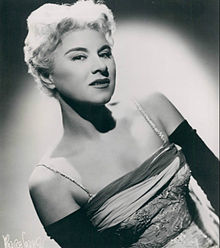
Summary
Hildegarde Loretta Sell, known as Hildegarde (February 1, 1906 – July 29, 2005) was an American cabaret singer, who was well known for the song "Darling, Je Vous Aime Beaucoup".
Hildegarde | |
|---|---|
 Hildegarde in 1960 | |
| Background information | |
| Birth name | Hildegarde Loretta Sell |
| Also known as | Hildegarde |
| Born | February 1, 1906 Adell, Wisconsin, US |
| Died | July 29, 2005 (aged 99) Manhattan, New York, US |
| Genres | |
Early life edit
She was born Hildegarde Loretta Sell in Adell, Wisconsin,[1] and raised in New Holstein, Wisconsin, as a Roman Catholic in a family of German extraction. She trained at Marquette University's College of Music in the 1920s.[2]
Vaudeville and cabaret edit
Hildegarde worked in vaudeville and traveling shows throughout her career, appearing across the United States and Europe. She was known for 70 years as The Incomparable Hildegarde, a title bestowed on her by columnist Walter Winchell.[3] She was also nicknamed the "First Lady of the Supper Clubs" by Eleanor Roosevelt.[4]
She was once referred to as a "luscious, hazel-eyed Milwaukee blonde who sings the way Garbo looks".[5] During the peak of Hildegarde's popularity in the 1930s and 1940s, she was booked in cabarets and supper clubs at least 45 weeks a year. Her recordings sold in the hundreds of thousands, and her admirers ranged from soldiers during World War II to King Gustaf VI Adolf of Sweden and the Duke of Windsor. On some of her recordings, she was accompanied by band leader Carroll Gibbons. During most of the 1940s she appeared on Raleigh Room, an NBC Radio program.[4]
She wore elegant gowns and long gloves: "Miss Piggy stole the gloves idea from me," she once said. A noted flirt, Hildegarde told risqué anecdotes while giving long-stemmed roses to men in her audience. During one performance, she waltzed with a U.S. Senator. She is credited with starting a single-name vogue among entertainers. Investments and work in ads for a bottled-water company, barley vitamins and a bathtub device gave her a comfortable income through the rock era.[6]
She appeared on the cover of Life in 1939, and Revlon introduced a Hildegarde shade of lipstick and nail polish. She was an inspiration for Liberace, who once acknowledged her influence on his performances: "Hildegarde was perhaps the most famous supper-club entertainer who ever lived. I used to absorb all the things she was doing, all the showmanship she created. It was marvelous to watch her, wearing elegant gowns, surrounded with roses and playing with white gloves on. They used to literally roll out the red carpet for her".
Television and stage edit
From the 1950s through the 1970s, in addition to her cabaret performances and record albums, Hildegarde appeared in a number of television specials and toured with the national company of the Stephen Sondheim musical Follies.
She appeared as the celebrity mystery guest on What's My Line? on May 8, 1955. After a question from Bennett Cerf about her handing out roses, to which she replied "I don't hand them out, I throw them out!", Dorothy Kilgallen correctly guessed it was her.
Hildegarde sang a presidential nomination campaign song for Margaret Chase Smith's unsuccessful 1964 campaign for president; the song was called "Leave It to the Girls", and was written by Gladys Shelley.[7]
Personal life and death edit
Hildegarde never married, although she was quoted as saying, "I traveled all my life, met a lot of men, had a lot of romances, but it never worked out. It was always 'hello and goodbye'". She was the business partner and good friend of Anna Sosenko, an aspiring songwriter whom she met at a boarding house in Camden, New Jersey at the beginning of her career.[4] That relationship ended in litigation over the control of receipts from their joint efforts. Her autobiography, Over 50... So What!, was published by Doubleday in 1961.
She died at the age of 99 in a Manhattan hospital on July 29, 2005, of natural causes.[4]
References edit
- ^ "Birth Record Details". Wisconsin Historical Society. Archived from the original on June 11, 2011. Retrieved July 23, 2009.
- ^ "Hildegarde (Loretta Sell) Papers". Marquette University Archives. Retrieved October 5, 2017.
- ^ "Museum Object of the Week: The "Incomparable" Hildegarde Record". Wisconsin Historical Society. Archived from the original on February 17, 2007. Retrieved January 31, 2013.
- ^ a b c d Bernstein, Adam (August 1, 2005). "Cabaret Performer Hildegarde Dies at 99". The Washington Post. Retrieved November 3, 2011.
- ^ "Radio: Art & Tires". Time. March 13, 1939. Retrieved March 6, 2019.
- ^ "Cabaret singer Hildegarde is dead at 99". The Seattle Times. Associated Press. August 1, 2005. Retrieved January 31, 2013.
- ^ 🖉"November/December 2016 - Madam President: The Struggle to Break the Last Glass Ceiling by Cyndy Bittinger". www.vermontwoman.com.
External links edit
- Biography on MusicBizAdvice.com
- Hildegarde at IMDb
- Biography at BigBands and BigNames.com
- Hear an episode of her radio show, "Hildegarde's Raleigh Room"
Archives edit
- Hildegarde Sell Papers in the Marquette University Archives
- Hildegarde papers, 1936-1978, held by the Billy Rose Theatre Division, New York Public Library for the Performing Arts


